November 1 2010
1
01
/11
/November
/2010
08:05
Published by The Baguette
-
in
Catholocism
October 28 2010
4
28
/10
/October
/2010
11:14
Published by The Baguette
-
in
Nature
October 24 2010
7
24
/10
/October
/2010
08:15
 Cette chapelle ancienne est visible de la route, au passage du village de la Rivière en allant vers Urville. Couverte en lose et blottie en bas de la cavée, au pied de ses grands pins, elle garde l’humilité des petits sanctuaires locaux imprégnés de la foi des ancêtres. «Cette Maison de Dieu et des hommes», inaccessible et fermée par mesure de sécurité publique, attend une hypothétique restauration pour une destination à trouver.
Cette chapelle ancienne est visible de la route, au passage du village de la Rivière en allant vers Urville. Couverte en lose et blottie en bas de la cavée, au pied de ses grands pins, elle garde l’humilité des petits sanctuaires locaux imprégnés de la foi des ancêtres. «Cette Maison de Dieu et des hommes», inaccessible et fermée par mesure de sécurité publique, attend une hypothétique restauration pour une destination à trouver.
Published by The Baguette
-
in
Catholocism
October 16 2010
6
16
/10
/October
/2010
08:41
 In 1145, the Empress Matilda (1102-1167), daughter of Henry I of England and granddaughter of William the Conqueror, asked for an abbey dedicated to the Virgin to be built here.
In 1145, the Empress Matilda (1102-1167), daughter of Henry I of England and granddaughter of William the Conqueror, asked for an abbey dedicated to the Virgin to be built here.  Legend has it that, she was traveling from England to France when her ship began to flounder during a terrible storm. She implored the Virgin to save her, vowing to erect a church wherever the ship landed safely. Sighting the coast, the captain of the ship reportedly told the queen, “Chante Reine, voici la terre!” (Queen sing, here is the earth!).
Legend has it that, she was traveling from England to France when her ship began to flounder during a terrible storm. She implored the Virgin to save her, vowing to erect a church wherever the ship landed safely. Sighting the coast, the captain of the ship reportedly told the queen, “Chante Reine, voici la terre!” (Queen sing, here is the earth!).  Consequently, this area of land earned the name of Chantereyne which it is still called to this day. However, this story is not present in any chronicle of the time. According to local historian, Robert Lerouvillois, the name Chantereyne refers to the many frogs that croaked in the marshy area.
Consequently, this area of land earned the name of Chantereyne which it is still called to this day. However, this story is not present in any chronicle of the time. According to local historian, Robert Lerouvillois, the name Chantereyne refers to the many frogs that croaked in the marshy area.  The abbey was consecrated in 1181, fourteen years after Matilda's death and was named the “Abbey of the Vow.” Her son, Henry II (1133-1189), henceforth King of England and Duke of Normandy, continued the work undertaken by his mother.
The abbey was consecrated in 1181, fourteen years after Matilda's death and was named the “Abbey of the Vow.” Her son, Henry II (1133-1189), henceforth King of England and Duke of Normandy, continued the work undertaken by his mother.  In 1532 the religious head of the abbey was replaced by a secular figure which began a period of decadence. The abbey could not maintain itself with a diminished income and gradually fell into ruin. In 1758, after the last English raid, the town authorities decided to change Cherbourg into a naval port, thus requiring the annexation of the abbey’s lands.
In 1532 the religious head of the abbey was replaced by a secular figure which began a period of decadence. The abbey could not maintain itself with a diminished income and gradually fell into ruin. In 1758, after the last English raid, the town authorities decided to change Cherbourg into a naval port, thus requiring the annexation of the abbey’s lands.  By 1774 religious life at the abbey ceased to exist. From 1793 to 1866, the buildings were transformed into a hospital and eventually a military barracks. Until the dawn of the 20th century, the navy used the abbey as a store. The abbey has suffered many misfortunes. It was attacked several times during the Hundred Years War as well as being heavily damaged by the Germans during World War II.
By 1774 religious life at the abbey ceased to exist. From 1793 to 1866, the buildings were transformed into a hospital and eventually a military barracks. Until the dawn of the 20th century, the navy used the abbey as a store. The abbey has suffered many misfortunes. It was attacked several times during the Hundred Years War as well as being heavily damaged by the Germans during World War II.  Listed as a historic monument since 1913, the site is currently under restoration. A number of archaeological finds were made there in 1994, in particular an exceptional gravestone for a priest from Querqueville named Guillaume Argène de Rai dating from 1280. A detailed survey of the site can be found here as a PDF file.
Listed as a historic monument since 1913, the site is currently under restoration. A number of archaeological finds were made there in 1994, in particular an exceptional gravestone for a priest from Querqueville named Guillaume Argène de Rai dating from 1280. A detailed survey of the site can be found here as a PDF file. 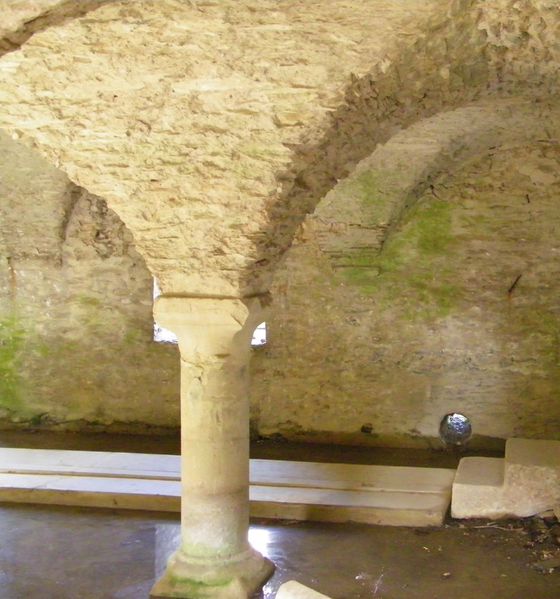 The abbey is open by appointment only except during the summer months of July and August when it is open on Sundays at 14h30.
The abbey is open by appointment only except during the summer months of July and August when it is open on Sundays at 14h30.
Published by The Baguette
-
in
Cultural Heritage
October 11 2010
1
11
/10
/October
/2010
08:42
Published by The Baguette
-
in
Cherbourg
October 6 2010
3
06
/10
/October
/2010
15:17
Published by The Baguette
-
in
Équeurdreville
October 4 2010
1
04
/10
/October
/2010
08:21
Published by The Baguette
-
in
Happy Things
October 1 2010
5
01
/10
/October
/2010
16:56
 Place du Théâtre
Place du Théâtre

 Des choux
Des choux
 De l’ail
De l’ail
 Des panais
Des panais
 Des courges
Des courges
 Des salades
Des salades
 Des fromages
Des fromages
Published by The Baguette
-
in
Cherbourg
September 23 2010
4
23
/09
/September
/2010
07:13
 La chapelle Saint-Germain is located atop a hill, 600 meters from the shore of Querqueville, overlooking the sea. Since 1856 it has been listed as a Historic Monument due to its early-Christian elements that make it one of the earliest surviving Christian worship sites in Normandy. It was open last weekend for the Journées européennes du patrimoine (European Heritage Days). Some stories suggest that it has been a religious site since the 5th century when in 450 “Germain le Scot” (son of an Irish prince) landed in what is now Diélette and began converting the local pagans and Roman settlers in La Hague to Christianity. Around 480, when he was preaching in Rouen, his words upset a local chief named Hubalt who then used his sword to decapitate Germain. Most historians and archaeologists agree that evidence supports the construction of the chapel from somewhere between the 9th and 12th centuries. Its advantageous position at the top of the hill allowed for monitoring of the sea for possible enemies wishing to come ashore. The name Querqueville actually comes from the Norse word “kirkja” which means "church" and the Norman word “ville”, which meant “agricultural realm”; Querqueville means literally the "realm of the church."
La chapelle Saint-Germain is located atop a hill, 600 meters from the shore of Querqueville, overlooking the sea. Since 1856 it has been listed as a Historic Monument due to its early-Christian elements that make it one of the earliest surviving Christian worship sites in Normandy. It was open last weekend for the Journées européennes du patrimoine (European Heritage Days). Some stories suggest that it has been a religious site since the 5th century when in 450 “Germain le Scot” (son of an Irish prince) landed in what is now Diélette and began converting the local pagans and Roman settlers in La Hague to Christianity. Around 480, when he was preaching in Rouen, his words upset a local chief named Hubalt who then used his sword to decapitate Germain. Most historians and archaeologists agree that evidence supports the construction of the chapel from somewhere between the 9th and 12th centuries. Its advantageous position at the top of the hill allowed for monitoring of the sea for possible enemies wishing to come ashore. The name Querqueville actually comes from the Norse word “kirkja” which means "church" and the Norman word “ville”, which meant “agricultural realm”; Querqueville means literally the "realm of the church." 
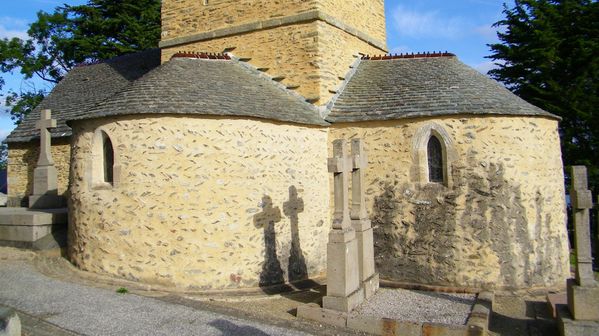 La chapelle Saint-Germain is a small building oriented east to west and consists of a small rectangular nave with three semi-circular apsidal projections called cul-de-four.
La chapelle Saint-Germain is a small building oriented east to west and consists of a small rectangular nave with three semi-circular apsidal projections called cul-de-four. 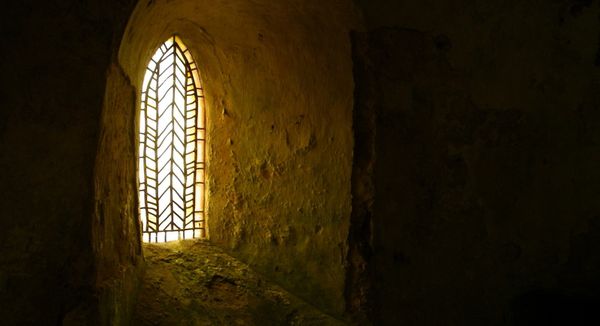
 The steeple was created in 1655 and the small stained glass windows were installed in 1985. One enters through the narthex and descends three small steps to the original foundation level of the chapel, uncovered during excavations between 1975 and 1977.
The steeple was created in 1655 and the small stained glass windows were installed in 1985. One enters through the narthex and descends three small steps to the original foundation level of the chapel, uncovered during excavations between 1975 and 1977.  Soundings and other investigations at that time found the existence of a very old cemetery complete with four sarcophagi underneath the choir. These two photos show the layout of the four sarcophagi found to be under the choir.
Soundings and other investigations at that time found the existence of a very old cemetery complete with four sarcophagi underneath the choir. These two photos show the layout of the four sarcophagi found to be under the choir. 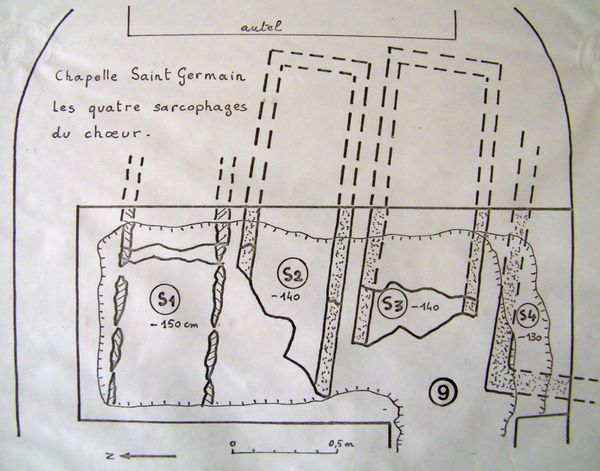
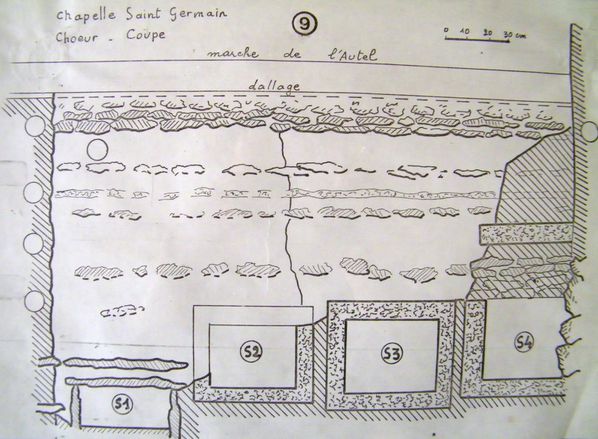 They also found original columns and wall foundations, coins from different eras as well as a granite mortuary slab with the carving of a croix nimbée
They also found original columns and wall foundations, coins from different eras as well as a granite mortuary slab with the carving of a croix nimbée 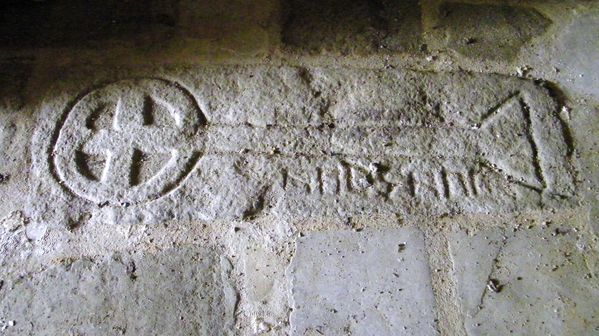 (cross with a halo) near the entrance of the northern apse. Ancient frescoes uncovered on the apsidal walls represent a man carrying a Bible, a tonsured figure with donkey ears and several other characters.
(cross with a halo) near the entrance of the northern apse. Ancient frescoes uncovered on the apsidal walls represent a man carrying a Bible, a tonsured figure with donkey ears and several other characters. 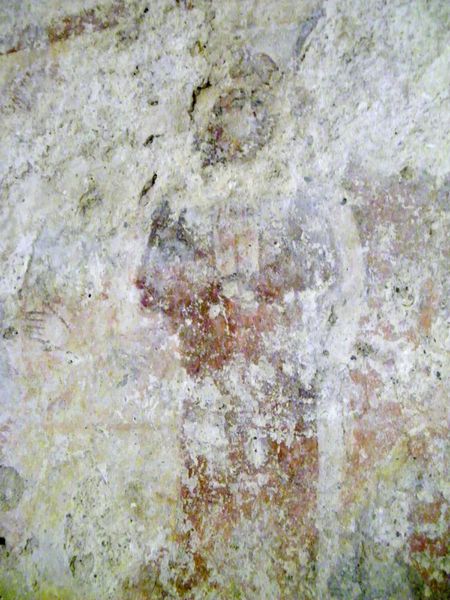

 On the floor of the southern apse lies a 16th century large crucifix of polychrome wood. This used to hang on the northern wall near the entrance but due to recent works, it has been set out of the way.
On the floor of the southern apse lies a 16th century large crucifix of polychrome wood. This used to hang on the northern wall near the entrance but due to recent works, it has been set out of the way. 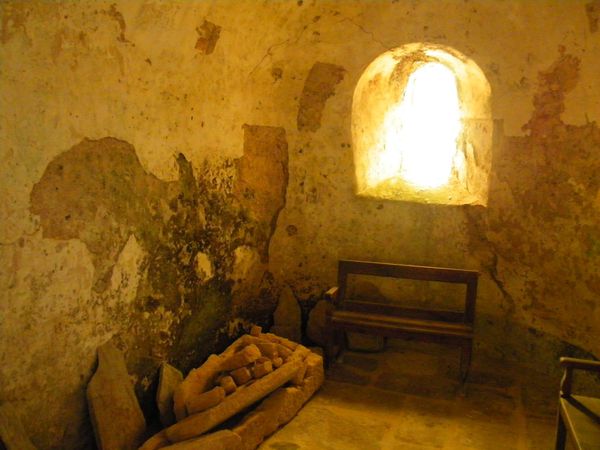 The southern apse has the remains of a sarcophagus unearthed during the excavations in 1975-1977.
The southern apse has the remains of a sarcophagus unearthed during the excavations in 1975-1977.  There are three statues resting in front of the altar. The first statue is of Saint-Hélier in polychrome stone. It dates from the 15th century. He holds his decapitated head in his hands. Companion of Saint-Marcouf, Saint-Hélier helped to evangelize the island of Jersey in the mid-6th century. He was beheaded by a horde of Saxons in 559. The statue in the middle is of Saint-Clair in polychrome stone holding his head in his hands. The third one is also of Saint-Clair in polychrome wood and placed in the chapel in 1791. It comes from La chapelle Saint-Clair de Nacqueville and is especially interesting since the statue depicts a priest wearing his cap, surplice and stole and extending his hands in a gesture of giving. Most statues of Saint-Clair (like the one in the middle) depict the saint without his head. He was born in England and landed near Cherbourg in 860 to evangelize the local people. He established his hermitage in the forest of Nacqueville. One of his followers is said to have cut off his own hand while chopping wood but through the prayers of Clair the hermit, he was healed. Other stories have
There are three statues resting in front of the altar. The first statue is of Saint-Hélier in polychrome stone. It dates from the 15th century. He holds his decapitated head in his hands. Companion of Saint-Marcouf, Saint-Hélier helped to evangelize the island of Jersey in the mid-6th century. He was beheaded by a horde of Saxons in 559. The statue in the middle is of Saint-Clair in polychrome stone holding his head in his hands. The third one is also of Saint-Clair in polychrome wood and placed in the chapel in 1791. It comes from La chapelle Saint-Clair de Nacqueville and is especially interesting since the statue depicts a priest wearing his cap, surplice and stole and extending his hands in a gesture of giving. Most statues of Saint-Clair (like the one in the middle) depict the saint without his head. He was born in England and landed near Cherbourg in 860 to evangelize the local people. He established his hermitage in the forest of Nacqueville. One of his followers is said to have cut off his own hand while chopping wood but through the prayers of Clair the hermit, he was healed. Other stories have  Clair casting out demons and bringing people back to life. His martyrdom came about when a rich and powerful woman set her sights on the handsome young monk. Fearing her carnal intentions and wishing to escape the notoriety that came from performing miracles, he fled to Vulcassum in the Val-d’Oise region. The frustrated and implacable woman had her soldiers pursue Clair until 12 years later they finally found him. When asked if he knew of someone named Clair, he replied, “No.” As the men began to turn away, Clair felt he committed a sin by hiding the truth and called out, “I am Clair.” Then, kneeling with his head down he said, “Perish the body that may be the subject of a criminal love.” One of the men cut off his head and threw it into a fountain. When the killers fled, Clair dived into the water, grabbed his head and went to his oratory. From there he went to the church where he finally died beside the altar. The fountain is said to have healing powers. It is EXCEPTIONALLY difficult to find detailed information about La Chapelle Saint-Germain unless one visits during the Journées européennes du patrimoine (European Heritage Days). Knowing that so much information is not yet on the internet, I took photographs of the charts and detailed excavation histories which hang within the chapel:
Clair casting out demons and bringing people back to life. His martyrdom came about when a rich and powerful woman set her sights on the handsome young monk. Fearing her carnal intentions and wishing to escape the notoriety that came from performing miracles, he fled to Vulcassum in the Val-d’Oise region. The frustrated and implacable woman had her soldiers pursue Clair until 12 years later they finally found him. When asked if he knew of someone named Clair, he replied, “No.” As the men began to turn away, Clair felt he committed a sin by hiding the truth and called out, “I am Clair.” Then, kneeling with his head down he said, “Perish the body that may be the subject of a criminal love.” One of the men cut off his head and threw it into a fountain. When the killers fled, Clair dived into the water, grabbed his head and went to his oratory. From there he went to the church where he finally died beside the altar. The fountain is said to have healing powers. It is EXCEPTIONALLY difficult to find detailed information about La Chapelle Saint-Germain unless one visits during the Journées européennes du patrimoine (European Heritage Days). Knowing that so much information is not yet on the internet, I took photographs of the charts and detailed excavation histories which hang within the chapel: 
 The photos above detail the excavation works and soundings taken by archaeologists between 1975 - 1977.
The photos above detail the excavation works and soundings taken by archaeologists between 1975 - 1977. The map above shows where things are located but is not very recent since the statues are no longer placed throughout the chapel but rest at the foot of the altar. The following four pages are difficult to read since they are in terrible handwriting but if you have the courage and can read them, feel free to give them a go! They tell the story of the chapel and the histories of the saints found inside.
The map above shows where things are located but is not very recent since the statues are no longer placed throughout the chapel but rest at the foot of the altar. The following four pages are difficult to read since they are in terrible handwriting but if you have the courage and can read them, feel free to give them a go! They tell the story of the chapel and the histories of the saints found inside.


Published by The Baguette
-
in
Cotentin
September 20 2010
1
20
/09
/September
/2010
15:07
 The Château de Tocqueville was originally a manor house constructed over three different periods during the 16th, 18th and 19th centuries. While retaining its smooth appearance, the architectural diversity gives the château its particular charm. It is most famous for being the home of Alexis de Tocqueville (1805 – 1859), famous intellectual, sociologist and politician.
The Château de Tocqueville was originally a manor house constructed over three different periods during the 16th, 18th and 19th centuries. While retaining its smooth appearance, the architectural diversity gives the château its particular charm. It is most famous for being the home of Alexis de Tocqueville (1805 – 1859), famous intellectual, sociologist and politician.  When he saw it for the first time in 1833, he was immediately charmed by its feeling of serenity. In 1836, after the death of his mother, he inherited the property. It became the place where he and his wife Marie found tranquility and inspiration and where he worked on his books, including The Old Regime and the Revolution and his most famous work, Democracy in America.
When he saw it for the first time in 1833, he was immediately charmed by its feeling of serenity. In 1836, after the death of his mother, he inherited the property. It became the place where he and his wife Marie found tranquility and inspiration and where he worked on his books, including The Old Regime and the Revolution and his most famous work, Democracy in America. 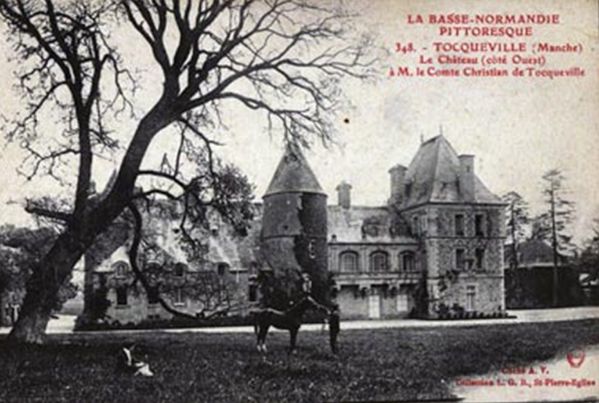
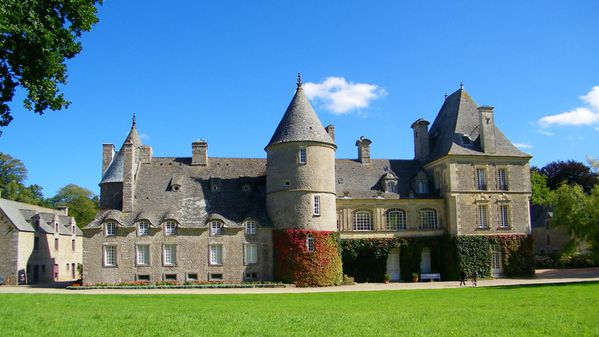 The château is still a private residence safeguarded by the current Countess de Tocqueville and rarely open to the public. However, the grounds of the château are open during the Journées européennes du patrimoine (European Heritage Days) which took place last weekend (18 – 19 September). In the 16th century, the property consisted of a large Norman house flanked by two round towers. A third tower which served as a pigeonnier (dovecote) stood at the extreme edge of the courtyard and was accessible through a porch. In 1840, the porch was moved stone by stone in order to create more space for the courtyard.
The château is still a private residence safeguarded by the current Countess de Tocqueville and rarely open to the public. However, the grounds of the château are open during the Journées européennes du patrimoine (European Heritage Days) which took place last weekend (18 – 19 September). In the 16th century, the property consisted of a large Norman house flanked by two round towers. A third tower which served as a pigeonnier (dovecote) stood at the extreme edge of the courtyard and was accessible through a porch. In 1840, the porch was moved stone by stone in order to create more space for the courtyard.  Already in the 16th century, the house was considered a noble house, as indicated by the band that encircles the stone dovecote. In those days only noble landowners could maintain dovecotes on their property.
Already in the 16th century, the house was considered a noble house, as indicated by the band that encircles the stone dovecote. In those days only noble landowners could maintain dovecotes on their property.  Inside the dovecote, there are 2500 boulins (boxes where pigeons could rest). In 1661, the manor became the property of the Clérel family through an alliance with the local Rampan family. By becoming the owners of Tocqueville, they took the name of the fief. Since that time, the château has belonged to the Tocqueville family and has never come up for sale.
Inside the dovecote, there are 2500 boulins (boxes where pigeons could rest). In 1661, the manor became the property of the Clérel family through an alliance with the local Rampan family. By becoming the owners of Tocqueville, they took the name of the fief. Since that time, the château has belonged to the Tocqueville family and has never come up for sale.  Throughout the 18th century, the Tocqueville family created allies through marriages with large families close to the royal court. This improved their financial position and permitted the conversion of the manor into a château. The current façade was added and the southern wing was extended.
Throughout the 18th century, the Tocqueville family created allies through marriages with large families close to the royal court. This improved their financial position and permitted the conversion of the manor into a château. The current façade was added and the southern wing was extended.  The château was made complete with the construction of the guardhouse and commons. During the French Revolutionary period, there was no major impact on the property except for the destruction of the dovecote’s roof, symbol of nobility, and the black blurring of the word "king" in the literature of the library.
The château was made complete with the construction of the guardhouse and commons. During the French Revolutionary period, there was no major impact on the property except for the destruction of the dovecote’s roof, symbol of nobility, and the black blurring of the word "king" in the literature of the library.  In the 19th century, Alexis de Tocqueville wanted to build an English garden, which was fashionable at the time. He knocked down fences and the surrounding the groves and converted the space by adding a large pond to the front of the château.
In the 19th century, Alexis de Tocqueville wanted to build an English garden, which was fashionable at the time. He knocked down fences and the surrounding the groves and converted the space by adding a large pond to the front of the château.  Finally, in 1896 Count Christian de Tocqueville added Renaissance inspiration to the chateau by building the square addition to the southern wing. In 1954, a fire devastated the château. The family decided to rebuild everything in the original style and the chateau was brought back to life.
Finally, in 1896 Count Christian de Tocqueville added Renaissance inspiration to the chateau by building the square addition to the southern wing. In 1954, a fire devastated the château. The family decided to rebuild everything in the original style and the chateau was brought back to life.  The words carved in granite above the main door are in Latin: HOSPES INGREDERE BONI VULTUS ADERUNT which roughly translates to “All guests who enter are welcomed”.
The words carved in granite above the main door are in Latin: HOSPES INGREDERE BONI VULTUS ADERUNT which roughly translates to “All guests who enter are welcomed”.  The roof was clad in schist from Tourlaville and the pointing done in lime mortar, typical for many homes in the Val de Saire.
The roof was clad in schist from Tourlaville and the pointing done in lime mortar, typical for many homes in the Val de Saire. 

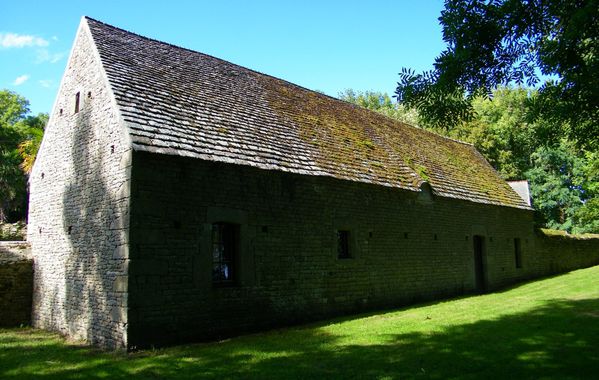
 One enters the property through a tree-lined avenue and arched gateway. After that, one must take a right through the commons which has its own bake house, garden with apple press and a large festival hall used to exhibit works based on the life of Alexis de Tocqueville.
One enters the property through a tree-lined avenue and arched gateway. After that, one must take a right through the commons which has its own bake house, garden with apple press and a large festival hall used to exhibit works based on the life of Alexis de Tocqueville. 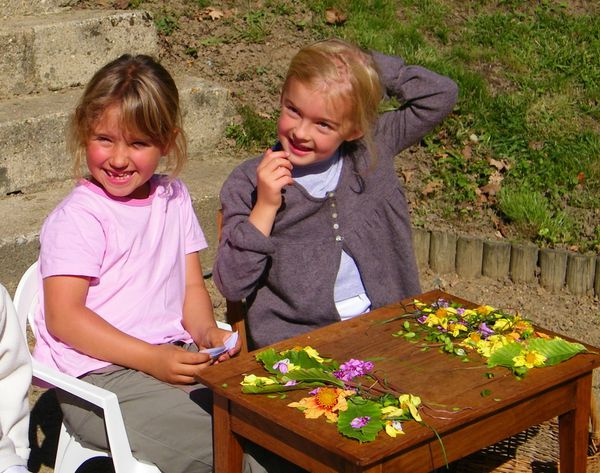 As a guest visiting the château I was welcomed by young children who were “selling flowers for free.” They were charming!
As a guest visiting the château I was welcomed by young children who were “selling flowers for free.” They were charming! 

 L’église St-Laurent in the village is a fine building from the early 18th century. It is designed as a nave flanked by an aisle. The portal and the three lancet windows are in the Gothic style. A big chapel opening in the choir was constructed in the 15th century by the Hennot family, lords of Tocqueville. In 1895, the church bell tower was heightened and finished with a double-pitched roof. The only object scheduled as a historic monument is a painting of the sacrifice of Abraham from the 17th century. Also of interest are a wooden lectern, 18th century fonts and two 15th century statues (vierge à l’enfant et Ste-Marthe).
L’église St-Laurent in the village is a fine building from the early 18th century. It is designed as a nave flanked by an aisle. The portal and the three lancet windows are in the Gothic style. A big chapel opening in the choir was constructed in the 15th century by the Hennot family, lords of Tocqueville. In 1895, the church bell tower was heightened and finished with a double-pitched roof. The only object scheduled as a historic monument is a painting of the sacrifice of Abraham from the 17th century. Also of interest are a wooden lectern, 18th century fonts and two 15th century statues (vierge à l’enfant et Ste-Marthe). 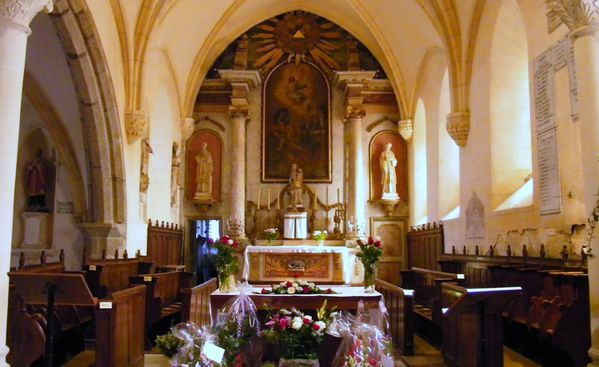 Since people were beginning to file in for a wedding, I was only able to take one photo of the altar before I left.
Since people were beginning to file in for a wedding, I was only able to take one photo of the altar before I left.
Published by The Baguette
-
in
Le Val de Saire









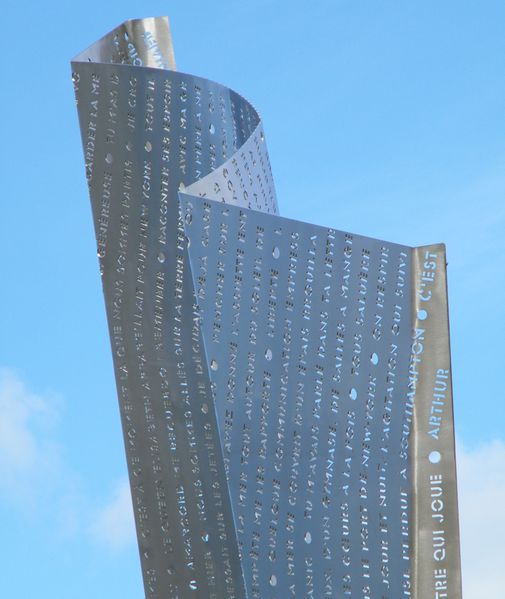
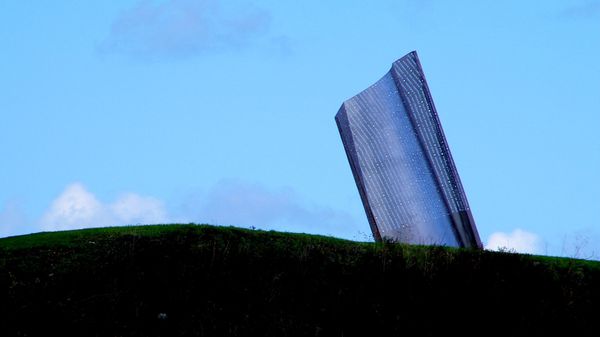












 The photos above detail the excavation works and soundings taken by archaeologists between 1975 - 1977.
The photos above detail the excavation works and soundings taken by archaeologists between 1975 - 1977. The map above shows where things are located but is not very recent since the statues are no longer placed throughout the chapel but rest at the foot of the altar. The following four pages are difficult to read since they are in terrible handwriting but if you have the courage and can read them, feel free to give them a go! They tell the story of the chapel and the histories of the saints found inside.
The map above shows where things are located but is not very recent since the statues are no longer placed throughout the chapel but rest at the foot of the altar. The following four pages are difficult to read since they are in terrible handwriting but if you have the courage and can read them, feel free to give them a go! They tell the story of the chapel and the histories of the saints found inside.






 Inside the dovecote, there are 2500 boulins (boxes where pigeons could rest). In 1661, the manor became the property of the Clérel family through an alliance with the local Rampan family. By becoming the owners of Tocqueville, they took the name of the fief. Since that time, the château has belonged to the Tocqueville family and has never come up for sale.
Inside the dovecote, there are 2500 boulins (boxes where pigeons could rest). In 1661, the manor became the property of the Clérel family through an alliance with the local Rampan family. By becoming the owners of Tocqueville, they took the name of the fief. Since that time, the château has belonged to the Tocqueville family and has never come up for sale. 









